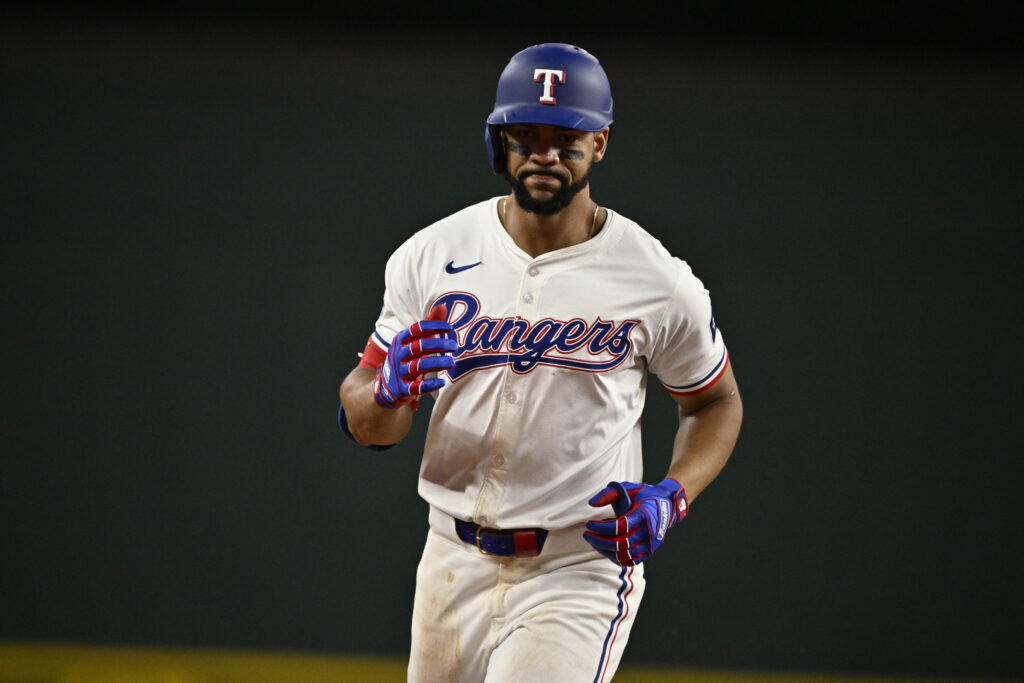
The Rangers have received calls from other teams regarding Leody Taveras, writes Evan Grant of the Dallas Morning News. There’s no indication that Texas is actively shopping the center fielder, but there’s logic to considering offers.
Texas looks as if they’ll enter the season right up against the $241MM luxury tax threshold. It has been clear since the beginning of the offseason that Texas doesn’t want to go beyond that number. They currently have around $235MM in tax obligations, according to the RosterResource calculations.
That’s an unofficial estimate, but the Rangers are in the ballpark of the CBT threshold. The tax number is calculated at the end of the season. Salaries acquired during the season (usually around the trade deadline) count against a team’s CBT hit on a prorated basis. Teams generally want to leave a few million dollars in payroll space for in-season maneuvering if they’re hoping to stay below the line.
Owner Ray Davis told Grant earlier this week that the team still intends to stay under the $241MM marker. Perhaps that thinking would change if the front office feels they’re one or two significant moves away at the deadline. For now, the goal is apparently to remain below the line to reset their tax bracket. Teams are hit with escalating penalties for exceeding the threshold in consecutive seasons. Texas paid around $10.8MM in taxes last year, their second straight season going above the line.
That’d put them in the third and highest tier of repeat payor for every season forward until they dip below. Third-time payors are charged a 50% tax on spending for their first $20MM in overages. That respectively jumps to 62% and 95% on their next $20MM increments, followed by a 110% tax on any spending that is more than $60MM above the base threshold. CBT payors also face tougher draft and signing bonus penalties if they sign free agents who declined a qualifying offer.
While a few teams (i.e. Dodgers, Yankees, Phillies, Mets) have been willing to exceed the thresholds repeatedly in recent years, most ownership groups prefer to avoid the escalating penalties. That’s evidently Davis’ goal as well. As Grant observes, even the projected $6MM in spending capacity is probably an overstatement. Salary unlocked via bonuses counts against a team’s tax number as it is triggered. That’s most relevant with rewards to Tyler Mahle, whose contract contains $5MM in innings-based incentives for the upcoming season. That could theoretically push his CBT number from its current $11MM figure as high as $16MM, which would nearly close the estimated gap on its own.
It leaves the front office with limited spending capacity both for the next few weeks and during the season … unless they offload payroll via trade. Taveras is one of the clearer candidates for such a move. He agreed to a $4.75MM salary for his second of four trips through the arbitration process. The Joc Pederson signing means the Rangers will play Wyatt Langford in left field on most days. That’ll push Evan Carter into center field, while Adolis García will get a rebound opportunity in right field.
Taveras nominally becomes the fourth outfielder. That’s understandable coming off a poor year. The lefty-hitting center fielder posted a modest .229/.289/.352 slash across 529 plate appearances. Defensive Runs Saved was also very down on his glovework, grading him 10 runs below average in more than 1200 innings. Statcast viewed his defense much more favorably, crediting him as five runs above average.
Statcast has graded Taveras as an above-average defender in every season of his career. DRS has been more mixed in its evaluation, though he has a decent +3 mark in his career overall. Texas has never played Taveras anywhere outside of center field. It’s likely that most teams would feel he’s at least a capable, if not outright plus, defender. The bat is more of a question, but he was a roughly league average hitter between 2022-23. Taveras combined for a .264/.311/.400 slash in nearly 900 trips to the plate over those two seasons.
This has been a cold offseason for teams looking for center field help. Harrison Bader, a .234/.279/.362 hitter over the last two seasons, is the top free agent at the position. The White Sox and Marlins are the only teams fully in rebuild mode. Miami doesn’t really have a center fielder to market. Chicago has held a high asking price on Luis Robert Jr. and looks likely to carry him into Spring Training.
MLBTR has speculatively highlighted Taveras as a potential fit for the Guardians, who could use another outfielder and would benefit from pushing Lane Thomas back to right field. (Cleveland’s collection of pre-arbitration relievers matches up nicely with a Texas team whose biggest question is probably still its bullpen.) The Giants, Royals and Angels are other potential options to acquire a center fielder. The Astros are also seeking a left-handed hitting outfielder, though the Rangers might be reluctant to help their in-state division rivals.
Texas would need to weigh the benefits of shopping Taveras against the risk that they’d need to rely on him heavily during the season. García is coming off a career-worst season in which he hit .224/.284/.400. Carter was limited to 45 games by a stress reaction in his back. He underwent postseason surgery. While he’s expected to be ready for Spring Training, the Rangers could have some concern about how he’ll hold up physically. If they keep Taveras, other candidates for a salary-clearing trade are Mahle ($11MM initial CBT hit), Jon Gray ($14MM), or Dane Dunning ($2.66MM).
This post was originally published on this site be sure to check out more of their content.









